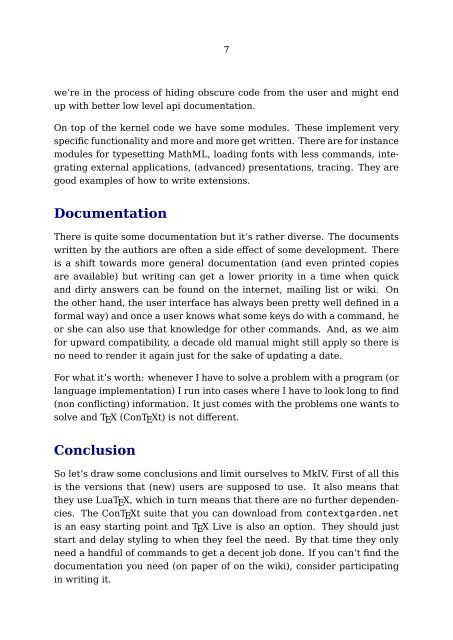What is ConTeXt - Pragma ADE
What is ConTeXt - Pragma ADE What is ConTeXt - Pragma ADE
7 we’re in the process of hiding obscure code from the user and might end up with better low level api documentation. On top of the kernel code we have some modules. These implement very specific functionality and more and more get written. There are for instance modules for typesetting MathML, loading fonts with less commands, integrating external applications, (advanced) presentations, tracing. They are good examples of how to write extensions. Documentation There is quite some documentation but it’s rather diverse. The documents written by the authors are often a side effect of some development. There is a shift towards more general documentation (and even printed copies are available) but writing can get a lower priority in a time when quick and dirty answers can be found on the internet, mailing list or wiki. On the other hand, the user interface has always been pretty well defined in a formal way) and once a user knows what some keys do with a command, he or she can also use that knowledge for other commands. And, as we aim for upward compatibility, a decade old manual might still apply so there is no need to render it again just for the sake of updating a date. For what it’s worth: whenever I have to solve a problem with a program (or language implementation) I run into cases where I have to look long to find (non conflicting) information. It just comes with the problems one wants to solve and T E X (ConT E Xt) is not different. Conclusion So let’s draw some conclusions and limit ourselves to MkIV. First of all this is the versions that (new) users are supposed to use. It also means that they use LuaT E X, which in turn means that there are no further dependencies. The ConT E Xt suite that you can download from contextgarden.net is an easy starting point and T E X Live is also an option. They should just start and delay styling to when they feel the need. By that time they only need a handful of commands to get a decent job done. If you can’t find the documentation you need (on paper of on the wiki), consider participating in writing it.
8 Hans Hagen PRAGMA ADE Hasselt NL October 30, 2011 www.pragma-ade.nl www.contextgarden.net
- Page 1 and 2: context
- Page 3 and 4: 2 [] for (optional) directives and
- Page 5 and 6: 4 When we started using LuaT E X, i
- Page 7: 6 of by pretty active crowd. The ad
7<br />
we’re in the process of hiding obscure code from the user and might end<br />
up with better low level api documentation.<br />
On top of the kernel code we have some modules. These implement very<br />
specific functionality and more and more get written. There are for instance<br />
modules for typesetting MathML, loading fonts with less commands, integrating<br />
external applications, (advanced) presentations, tracing. They are<br />
good examples of how to write extensions.<br />
Documentation<br />
There <strong>is</strong> quite some documentation but it’s rather diverse. The documents<br />
written by the authors are often a side effect of some development. There<br />
<strong>is</strong> a shift towards more general documentation (and even printed copies<br />
are available) but writing can get a lower priority in a time when quick<br />
and dirty answers can be found on the internet, mailing l<strong>is</strong>t or wiki. On<br />
the other hand, the user interface has always been pretty well defined in a<br />
formal way) and once a user knows what some keys do with a command, he<br />
or she can also use that knowledge for other commands. And, as we aim<br />
for upward compatibility, a decade old manual might still apply so there <strong>is</strong><br />
no need to render it again just for the sake of updating a date.<br />
For what it’s worth: whenever I have to solve a problem with a program (or<br />
language implementation) I run into cases where I have to look long to find<br />
(non conflicting) information. It just comes with the problems one wants to<br />
solve and T E X (ConT E Xt) <strong>is</strong> not different.<br />
Conclusion<br />
So let’s draw some conclusions and limit ourselves to MkIV. First of all th<strong>is</strong><br />
<strong>is</strong> the versions that (new) users are supposed to use. It also means that<br />
they use LuaT E X, which in turn means that there are no further dependencies.<br />
The ConT E Xt suite that you can download from contextgarden.net<br />
<strong>is</strong> an easy starting point and T E X Live <strong>is</strong> also an option. They should just<br />
start and delay styling to when they feel the need. By that time they only<br />
need a handful of commands to get a decent job done. If you can’t find the<br />
documentation you need (on paper of on the wiki), consider participating<br />
in writing it.



